1993 BUICK REGAL check oil
[x] Cancel search: check oilPage 223 of 308
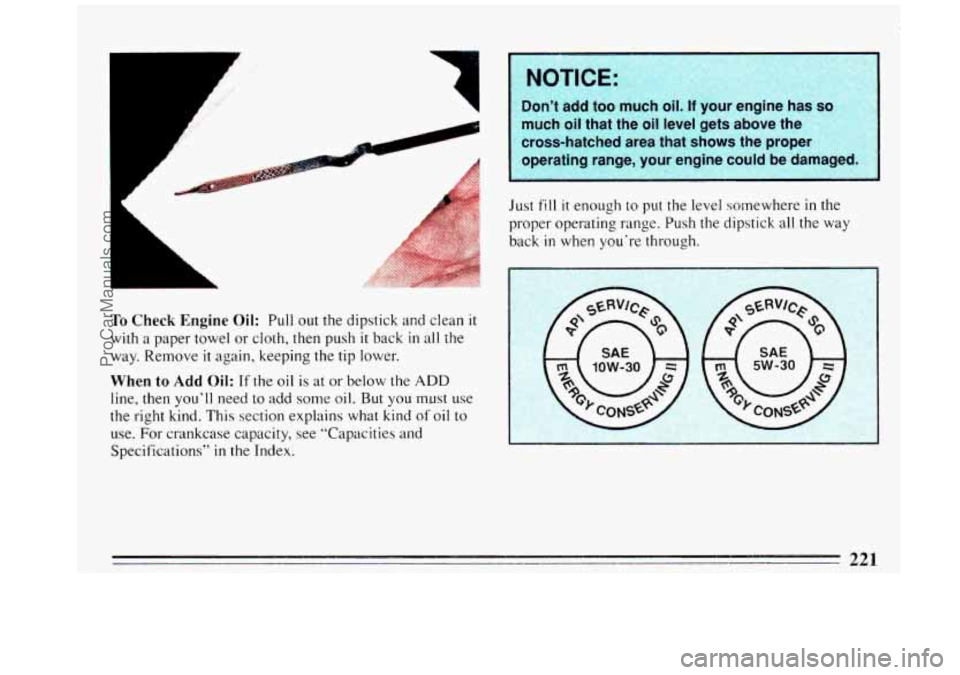
L
A
A
A
Don’t add too much oil. If your engine has so
much oil that the oil level gets above the
cross-hatched area that shows the proper
r operating range, your engine could be damaged. I il
r
Just fill it enough to put the level somewhere in the
proper operating range. Push the dipstick all
the way
back
in when you’re through. L
L
To Check Engine Oil: Pull out the dipstick and clean it
with a paper towel or cloth, then push it back in all the
way. Remove
it again, keeping the tip lower.
When to Add Oil: If the oil is at or below the ADD
line, then you’ll need to add some oil. But you must use
the right kind. This section explains what kind of
oil to
use. For crankcase capacity, see “Capacities and
Specifications”
in the Index.
I
I
22 1.
ProCarManuals.com
Page 228 of 308
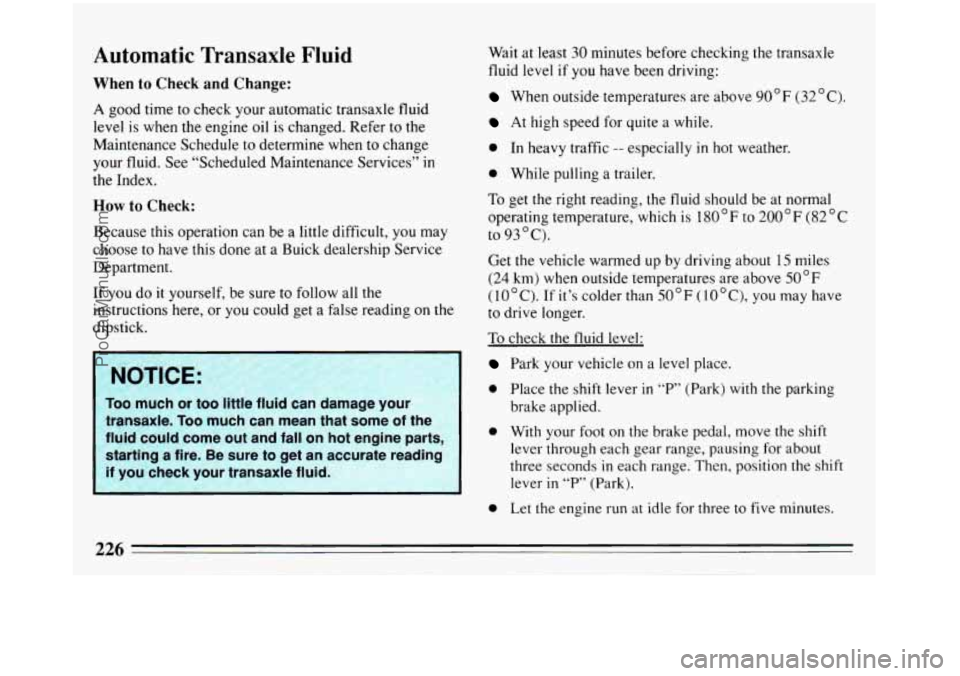
Automatic Transaxle Fluid
When to Check and Change:
A good time to check your automatic transaxle fluid
level is when
the engine oil is changed. Refer to the
Maintenance Schedule to determine when to change
your fluid. See “Scheduled Maintenance Services” in
the Index.
How to Check:
Because this operation can be a little difficult, you may
choose to have this done at a Buick dealership Service
Department.
If you do it yourself, be sure to follow all the
instructions here, or you could get a false reading on the
dipstick.
NOTICE:
Too much or too little fluid can damage your
transaxle.
Too much can mean that some of the
fluid could come out and fall
on hot engine parts,
starting a fire. Be sure to get an accurate reading
if you check your transaxle fluid.
Wait at least 30 minutes before checking the transaxle
fluid level if you have been driving:
When outside temperatures are above 90°F (32 ” C).
At high speed for quite a while.
0 In heavy traffic -- especially in hot weather.
0 While pulling a trailer.
To get the right reading, the fluid should be at normal
operating temperature, which is
180 F to 200 F (82 C
Get the vehicle warmed up by driving about 15 miles
(24 km) when outside temperatures are above
50°F
(10°C). If it’s colder than 50°F (lO°C), you may have
to drive longer.
To check the fluid level:
Park your vehicle on a level place.
0 Place the shift lever in “F’ (Park) with the parking
0 With your foot on the brake pedal, move the shift
to
93
O C).
brake applied.
lever through each gear range, pausing for about
three seconds
in each range. Then, position the shift
lever
in “P” (Park).
0 Let the engine run at idle for three to five minutes.
226
ProCarManuals.com
Page 230 of 308
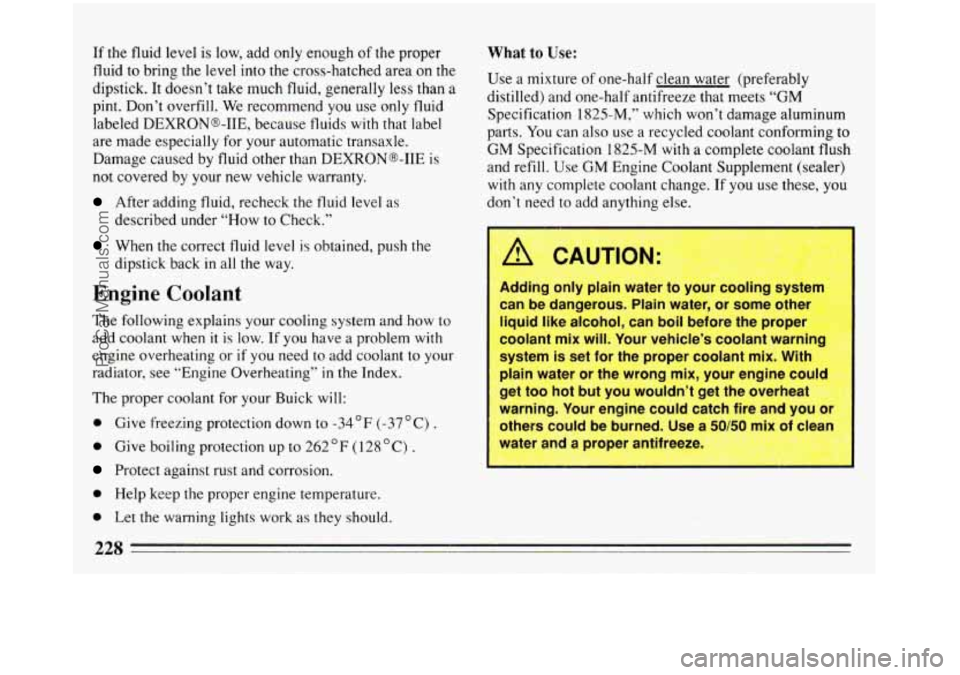
If the fluid level is low, add only enough of the proper
fluid to bring the level into the cross-hatched area on the
dipstick. It doesn’t take much fluid, generally less than a
pint. Don’t overfill. We recommend you use only fluid
labeled DEXRONB-IIE, because fluids with that label
are made especially for your automatic transaxle.
Damage caused by fluid other than DEXRONB-IIE is
not covered by your new vehicle warranty.
After adding fluid, recheck the fluid level as
described under “How
to Check.”
When the correct fluid level is obtained, push the
dipstick back in all the way.
Engine Coolant
The following explains your cooling system and how to
add coolant when
it is low. If you have a problem with
engine overheat.ing or if you need to add coolant to your
radiator, see “Engine Overheating”
in the Index.
The proper coolant for your Buick will:
0 Give freezing protection down to -34OF (-37OC) .
0 Give boiling protection up to 262 OF (128 “C) .
Protect against rust and corrosion.
0 Help keep the proper engine temperature.
0 Let the warning lights work as they should.
What to Use:
Use a mixture of one-half clean water (preferably
distilled) and one-half antifreeze that meets
“GM
Specification 1825-M,” which won’t damage aluminum
parts. You can also use a recycled coolant conforming to
GM Specification 1825-M with a complete coolant flush
and refill. Use GM Engine Coolant Supplement (sealer)
with any complete coolant change. If you use these, you
don’t need to add anything else.
can be aangerous. Plain water, or some other
liquid like alcohol, can boil before the proper
coolant mix will. Your vehicle’s coolant warning
system is set for the proper coolant mix. With
plain water or the wrong mix, your engine could
get too hot but you wouldn’t get the overhe-”
warning. Your engine could catch fire and
yuu or
others could be burned. Use a 50/50 mix of clean
water and a proper antifreeze.
G:~Z.+T~:, p:.t+d+s
228
ProCarManuals.com
Page 268 of 308
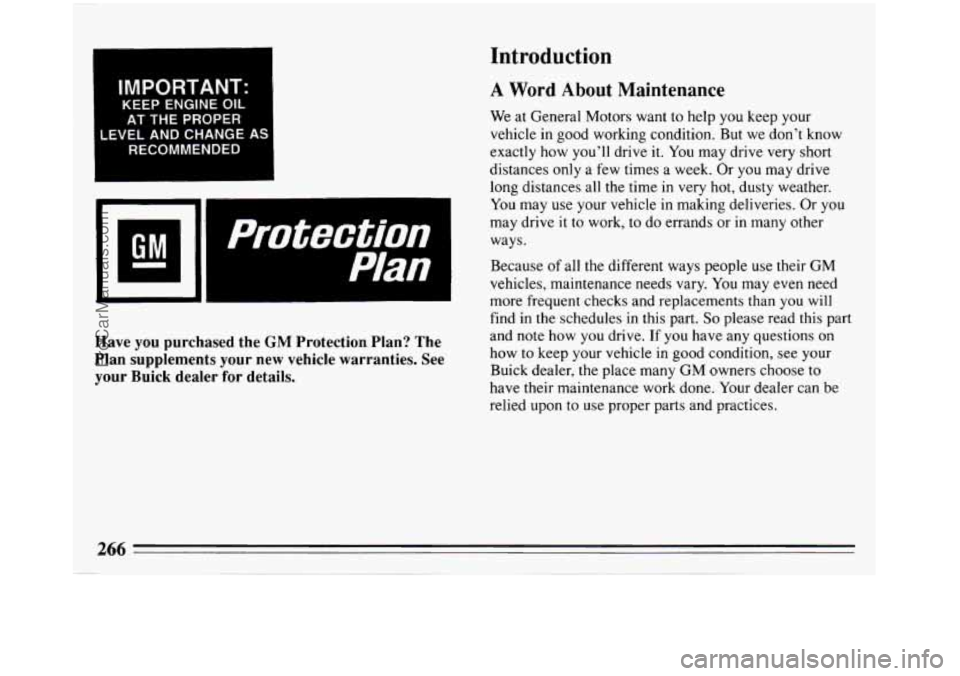
IMPORTANT:
KEEP ENGINE OIL
AT THE PROPER
LEVEL AND CHANGE AI
RECOMMENDED
’/an
Have you purchased the GM Protection Plan? The
Plan supplements your new vehicle warranties. See
your Buick dealer for details.
Introduction
A Word About Maintenance
We at General Motors want to help you keep your
vehicle in good working condition. But we don’t know
exactly how
you’ll drive it. You may drive very short
distances only
a few times a week. Or you may drive
long distances all the time in very
hot, dusty weather.
You may use your vehicle in making deliveries. Or you
may drive it to work, to
do errands or in many other
ways.
Because of all
the different ways people use their GM
vehicles, maintenance needs vary. You may even need
more frequent checks and replacements
than you will
find in the schedules in this part.
So please read this part
and note how
you drive. If you have any questions on
how
to keep your vehicle in good condition, see your
Buick dealer, the place many GM owners choose to
have their maintenance work done. Your dealer can be
relied upon to use proper parts and practices.
266
-
ProCarManuals.com
Page 276 of 308

Explanation of Scheduled Maintenance
Services
Below are explanations of the services listed in Schedule
I and Schedule 11.
The proper fluids and lubricants to use are listed in
Section D. Make sure whoever services your vehicle uses
these. All parts should be replaced and all necessary
repairs done before
you or anyone else drives the vehicle.
NOTE: To determine your engine’s displacement and
code, see “Engine Identification” in the Index.
1. Engine Oil and Filter Change* -- Always use SG
Energy Conserving I1 oils of proper viscosity. The
“SG” designation may be shown alone or in
combination with others, such as “SG/CC”, ,“SG/CD”
or
“SF, SG, CC,” etc. To determine the preferred
viscosity for your vehicle’s engine (e.g., SAE 5W-30
or SAE 10W-30), see “Engine Oil”
in the Index.
2. Chassis Lubrication -- Lubricate the transaxle shift
linkage, parking brake cable guides, underbody
contact points and linkage. If your vehicle is
equipped with grease fittings, lubricate
the
suspension and steering linkage. 3.
Throttle Body Mounting
Bolt Torque* -- Check
the torque
of the mounting bolts and/or nuts.
4. Tire and Wheel Rotation and Inspection -- For
proper wear and maximum tire life, rotate your tires
following the instructions
in this manual. See “Tires,
Inspection
& Rotation” in the Index. Check the tires
for uneven wear or damage. If you see irregular or
premature wear, check the wheel alignment. Check
for damaged wheels also.
5. Engine Accessory Drive Belt(s) Inspection --
Inspect the belt(s) for cracks, fraying, wear and
proper tension. Replace as needed.
6. Cooling System Service* -- Drain, flush and refill
the system
with new or approved recycled coolant
conforming to GM Specification 1825M. Keep
coolant at the proper mixture as specified. See
“Coolant”
in the Index. This provides proper freeze
protection, corrosion inhibitor level and engine
operating temperature.
Inspect hoses and replace
if they are cracked,
swollen or deteriorated. Tighten screw-type hose
clamps. Clean the outside
of the radiator and air
* An Emission Control Service.
The
U.S. Environmental Protection Agency has determined that the failure to perform this maintenance item will not nullify the emission warranty or limit recall liability prior tothe completion of vehicle useful life. General Motors, however, urges that all recommended maintenance \
services he performed at the indicatcd intervals and the maintenance be recorded in ”Section E:Maintenance Record”.
274
ProCarManuals.com
Page 278 of 308
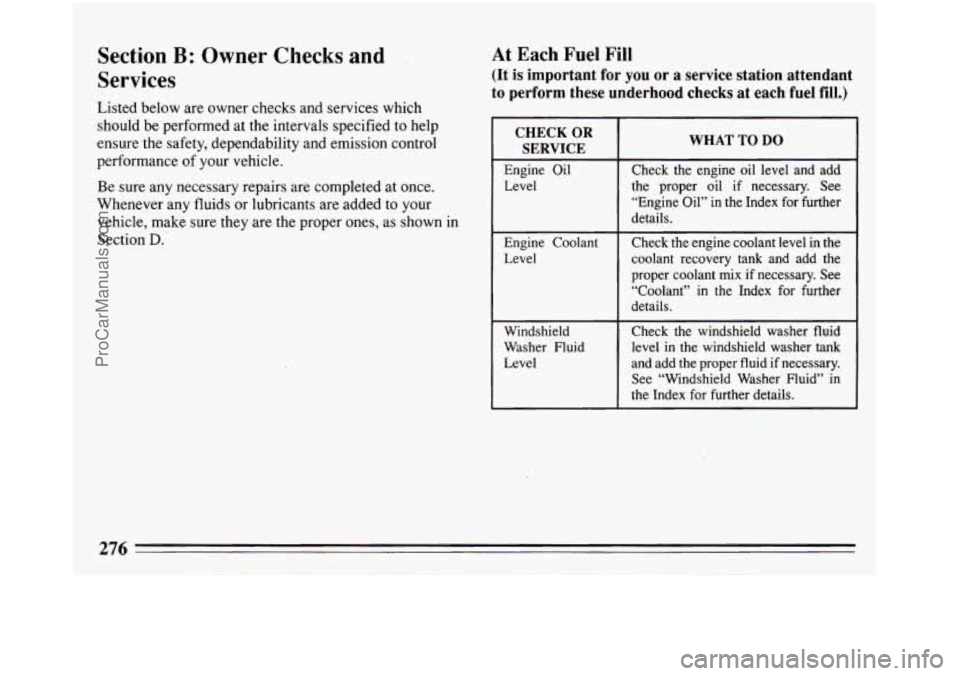
Section B: Owner Checks and
Services
Listed below are owner checks and services which
should be performed
at the intervals specified to help
ensure the safety, dependability and emission control
performance of your vehicle.
Be sure any necessary repairs are completed at once.
Whenever
any fluids or lubricants are added to your
vehicle, make sure they are the proper ones, as shown in
Section
D..
At Each Fuel Fill
(It is important for you or a service station attendant
to perform these underhood checks at each fuel
fill.)
WHAT TO DO
Engine Oil
the proper oil if necessary. See
Level Check the
engine oil level and add
“Engine
Oil” in the Index for further
details.
Engine Coolant coolant recovery tank and add the
Level Check the
engine coolant level in the
“Coolant”
in the Index for further
proper
coolant mix if necessary. See
details.
Windshield
level in the windshield washer tank
Washer Fluid Check
the windshield washer fluid
and add the proper fluid if necessary.
Level
See “Windshield Washer Fluid”
in
the Index for further details.
276
-
ProCarManuals.com
Page 282 of 308
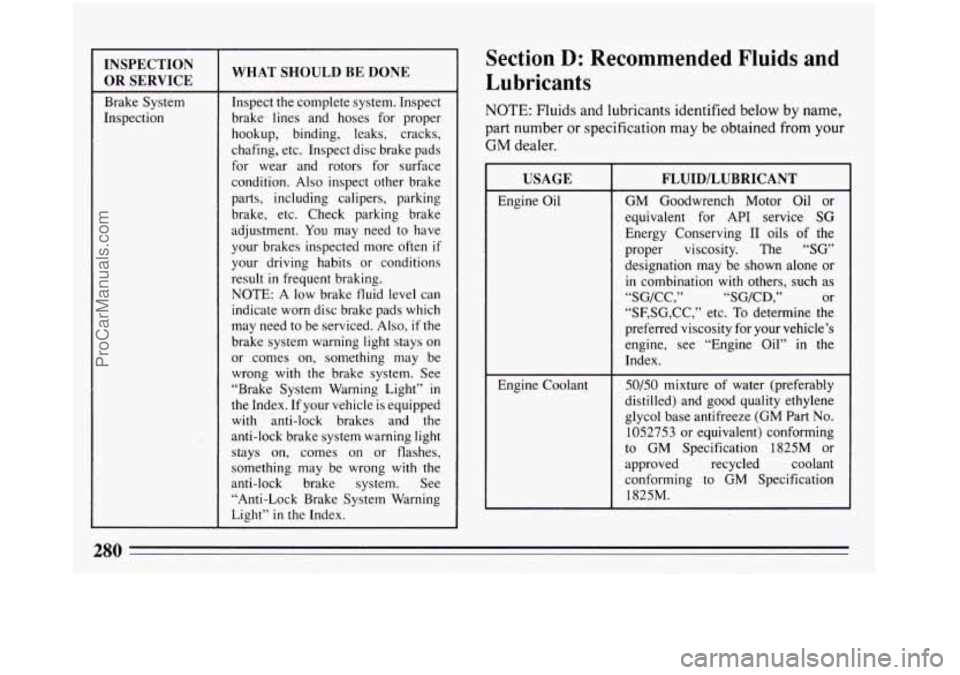
INSPECTION
OR SERVICE
Brake System
Inspection
WHAT SHOULD BE DONE
Inspect the complete system. Inspect
brake lines and hoses for proper
hookup, binding, leaks, cracks,
chafing, etc. Inspect disc brake pads
for wear and rotors for surface
condition. Also inspect other brake
parts, including calipers, parking
brake, etc. Check parking brake
adjustment. You may need to have
your brakes inspected more often
if
your driving habits or conditions
result
in frequent braking.
NOTE:
A low brake fluid level can
indicate worn disc brake pads which
may need to be serviced. Also, if the
brake system warning light stays on
or comes on, something may be
wrong with the brake system. See
“Brake System Warning Light”
in
the Index. If your vehicle is equipped
with anti-lock brakes and the
anti-lock brake system warning light
stays on, comes on or flashes,
something may be wrong with the
anti-lock brake system. See
“Anti-Lock Brake System Warning
Light”
in the Index.
Section D: Recommended Fluids and
Lubricants
NOTE: Fluids and lubricants identified below by name,
part number or specification may be obtained from your
GM dealer.
USAGE
Engine Oil
Engine Coolant
FLUID/LUBRICANT
GM Goodwrench Motor Oil or
equivalent for API service SG
Energy Conserving I1 oils of the
proper viscosity. The “SG”
designation may be shown alone or
in combination with others, such as
“SG/CC,” “SG/CD,”
or
“SF,SG,CC,” etc. To determine the
preferred viscosity for your vehicle’s
engine, see “Engine Oil” in the
Index.
50/50 mixture of water (preferably
distilled) and good quality ethylene
glycol base antifreeze (GM Part
No.
1052753 or equivalent) conforming
to
GM Specification 1825111 or
approved recycled coolant
conforming to
GM Specification
1825M.
ProCarManuals.com
Page 296 of 308
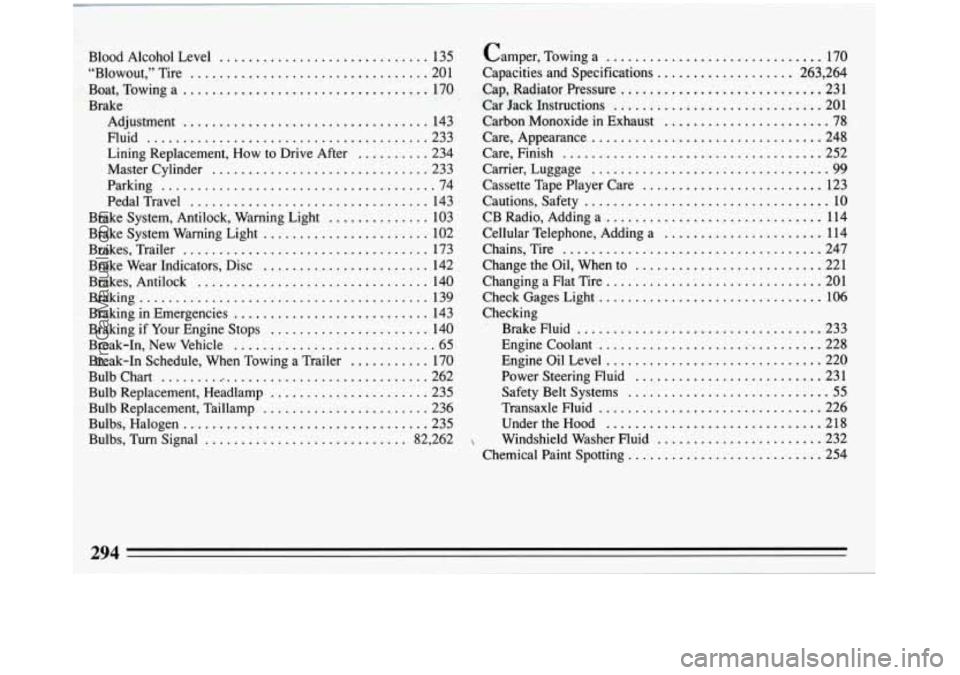
......................
?.'rrrrir.rr.*..s ..r.. *rrrlr)ry)r* 14p A ..
..... * ......... L . li e 0 $ 1 .... . i., . 5 ; ....... ?. . * .
Camper. Towing a .............................. 170
Capacities and Specifications ................... 263. 264
Car Jack Instructions ............................. 201
Carbon Monoxide in Exhaust ....................... 78
Care. Appearance ................................ 248
Care. Finish .................................... 252
Carrier. Luggage ................................. 99
Cassette Tape Player Care ......................... 123
Cautions. Safety .................................. 10
Cellular Telephone. Adding a ...................... 114
Chains. Tire .................................... 247
Changing a Flat Tire ............................... 201
Checking Cap. Radiator Pressure
............................ 231
CB Radio. Adding a .............................. 114
Change the Oil. When to .......................... 221
Check Gages Light ............................... 106
Brake Fluid .................................. 233
Engine Coolant ............................... 228
Engine Oil Level .............................. 220
Power Steering Fluid .......................... 231
Safety Belt Systems ............................ 55
Transaxle Fluid ............................... 226
Under the Hood ............................... 218
Windshield Washer Fluid ....................... 232
Chemical Paint Spotting ........................... 254
.
ProCarManuals.com